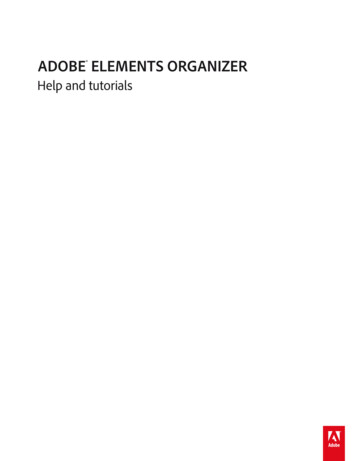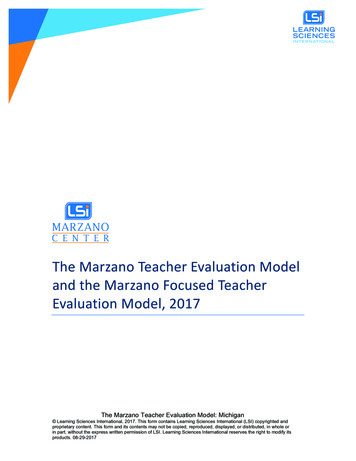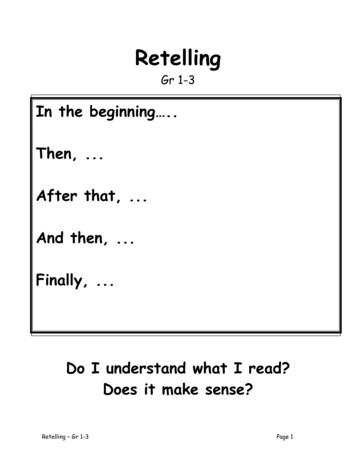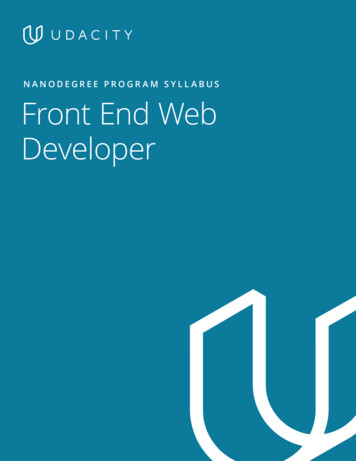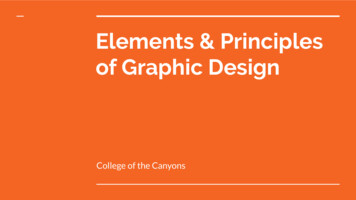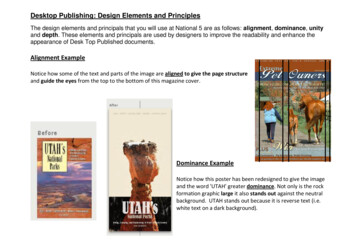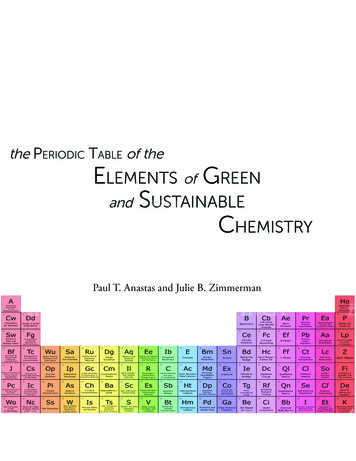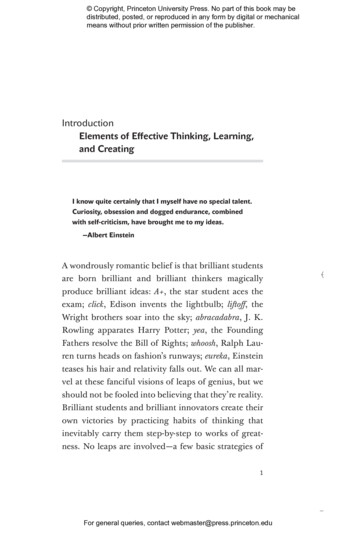
Transcription
Copyright, Princeton University Press. No part of this book may bedistributed, posted, or reproduced in any form by digital or mechanicalmeans without prior written permission of the publisher.IntroductionElements of Effective Thinking, Learning,and CreatingI know quite certainly that I myself have no special talent.Curiosity, obsession and dogged endurance, combinedwith self-criticism, have brought me to my ideas.—Albert EinsteinA wondrously romantic belief is that brilliant studentsare born brilliant and brilliant thinkers magicallyproduce brilliant ideas: A , the star student aces theexam; click, Edison invents the lightbulb; liftoff, theWright brothers soar into the sky; abracadabra, J. K.Rowling apparates Harry Potter; yea, the FoundingFathers resolve the Bill of Rights; whoosh, Ralph Lauren turns heads on fashion’s runways; eureka, Einsteinteases his hair and relativity falls out. We can all marvel at these fanciful visions of leaps of genius, but weshould not be fooled into believing that they’re reality.Brilliant students and brilliant innovators create theirown victories by practicing habits of thinking thatinevitably carry them step-by-step to works of greatness. No leaps are involved—a few basic strategies of1For general queries, contact webmaster@press.princeton.edu
Copyright, Princeton University Press. No part of this book may bedistributed, posted, or reproduced in any form by digital or mechanicalmeans without prior written permission of the publisher.2IN TRODUC T IONthought can lead to effective learning, understanding,and innovation. More importantly, you yourself canmaster and apply those strategies. This book presentspractical, proven methods of effective thinking andcreativity that lead to inevitable success in life.We, the authors, are teachers. We have taught hundreds of thousands of students and adults how to thinkmore effectively. Countless times we have encounteredindividuals with potential and watched the drama oflife’s transformation unfold—or not. Anne and Adamstruggle with ideas, understand the basics, learn frommistakes, ask questions—and thrive. Fiona and Frank,with the same native talent, start at the same place,but they memorize without understanding, fear error,avoid uncertainty—and do not succeed. This book isabout what makes the difference.Education does not stop with the end of your formalschooling. Even if your formal school days are longpast, you are still a student and, hopefully, will alwaysbe one. You can choose to learn habits of thought thatwill help you to meet the ongoing challenges of life—personal, professional, and societal.Imagine Marie Curie, Albert Einstein, and William Shakespeare as students. Today we know themas famous geniuses, but when they were in school,they didn’t walk around wearing a “FUTURE GENIUS”button. Instead, they just looked at the world differently by applying habits of mind that allowed themFor general queries, contact webmaster@press.princeton.edu
Copyright, Princeton University Press. No part of this book may bedistributed, posted, or reproduced in any form by digital or mechanicalmeans without prior written permission of the publisher.E L EM EN TS O F E FFECTIVE THIN KIN G3to discover and create new and profound ideas. Whilewe can celebrate famous geniuses and be inspired bytheir remarkable stories, this book is about you—areal person with strengths and weaknesses—not amythologized hero. Look down at your shirt—if youdon’t see a “FUTURE GENIUS” button, then you toohave the potential to innovate. Creativity is not a matter of magical inspiration. This book describes habitsthat will automatically cause you to regularly producenew knowledge and insight. Remember: Extraordinary people are just ordinary people who are thinkingdifferently—and that could be you.Ordinary students can attain extraordinary heights.Mark was one of our mathematics students whosework at the beginning of the semester was truly dismal. He was so lost that his homework assignmentswere neither right nor wrong—they were simply nonsense. He merely recycled math terms that he wrotedown during class discussions without even knowingtheir meaning. It was as if he were writing a poemin a language that he himself did not understand.Although he was genuinely dedicated, Mark appearedto be the textbook example of a lost cause.By the end of the semester, however, Mark hadtransformed himself into a different person—a personwho was able to think about mathematics in cleverand imaginative ways. As the term came to a close, hedevised a creative and correct solution to a difficult,For general queries, contact webmaster@press.princeton.edu
Copyright, Princeton University Press. No part of this book may bedistributed, posted, or reproduced in any form by digital or mechanicalmeans without prior written permission of the publisher.4IN TRODUC T IONlong-standing challenge that no one else in the classwas able to resolve. At some point during the semester,Mark had the epiphany that mathematics had meaning and that he could make sense of it. He returned tothe most basic ideas of the subject—ideas that he hadseen years before but never truly grasped. He floundered when he viewed learning as memorizing techniques and repeating words. He succeeded when hesought to understand fundamental ideas deeply. Withhis new mind-set, building up a solid understandingof the subject was relatively easy, and his success in theclass was inevitable.The principles of understanding the unknown andfinding creative insights that transformed Mark’s lifecan be taught, learned, and applied broadly across disciplines and professions. We have seen these methodsof thinking transform otherwise ordinary people intoinnovative leaders, authors, artists, financial gurus,teachers, film producers, scientists, and, in a numberof cases, multimillionaires.Education is what survives when what has been learnedhas been forgotten.—B. F. SkinnerGiven that we, the authors, are professors, it is notsurprising that many stories in this book take place inclassroom settings. However, we have also taught tensFor general queries, contact webmaster@press.princeton.edu
Copyright, Princeton University Press. No part of this book may bedistributed, posted, or reproduced in any form by digital or mechanicalmeans without prior written permission of the publisher.E L EM EN TS O F E FFECTIVE THIN KIN G5of thousands of lifelong learners. So when we offerillustrations from our school experiences, we hope thatyou will view them literally if you are in the classroom(as either a student or a teacher), or metaphorically ifyou now find yourself outside the ivy-covered walls ofthe academy. When Aesop wrote “The Tortoise and theHare,” he was not aiming exclusively at the turtle market. Throughout life we frequently face challenges analogous to taking tests, earning grades, and understanding course material. Instead of taking formal tests, weencounter daunting questions from employers or evenfamily and friends; instead of earning grades, we arejudged in the workplace and in social settings; insteadof understanding course material, we regularly need tomaster new skills and absorb new knowledge to keepup with a rapidly changing world. All our stories havedirect relevance to you and your life.Five elements of thinking and learningThe surprising fact is that just a few learnable strategies of thinking can make you more effective in theclassroom, the boardroom, and the living room. Youcan personally choose to become more successful byadopting five learnable habits, which, in this book,we not only explain in detail but also make concreteand practical. Here in this section we briefly introducethose important habits to come.For general queries, contact webmaster@press.princeton.edu
Copyright, Princeton University Press. No part of this book may bedistributed, posted, or reproduced in any form by digital or mechanicalmeans without prior written permission of the publisher.6IN TRODUC T IONUnderstand deeply:Don’t face complex issues head-on; first understandsimple ideas deeply. Clear the clutter and expose whatis really important. Be brutally honest about what youknow and don’t know. Then see what’s missing, identify the gaps, and fill them in. Let go of bias, prejudice, and preconceived notions. There are degrees tounderstanding (it’s not just a yes-or-no proposition)and you can always heighten yours. Rock-solid understanding is the foundation for success.Make mistakes:Fail to succeed. Intentionally get it wrong to inevitablyget it even more right. Mistakes are great teachers—they highlight unforeseen opportunities and holes inyour understanding. They also show you which way toturn next, and they ignite your imagination.Raise questions:Constantly create questions to clarify and extendyour understanding. What’s the real question? Working on the wrong questions can waste a lifetime.Ideas are in the air—the right questions will bringthem out and help you see connections that otherwise would have been invisible.Follow the flow of ideas:Look back to see where ideas came from and thenlook ahead to discover where those ideas may lead. AFor general queries, contact webmaster@press.princeton.edu
Copyright, Princeton University Press. No part of this book may bedistributed, posted, or reproduced in any form by digital or mechanicalmeans without prior written permission of the publisher.EL E ME NTS OF EF FECTIVE THIN KIN G7new idea is a beginning, not an end. Ideas are rare—milk them. Following the consequences of smallideas can result in big payoffs.These four building blocks are basic elements foreffective thinking, and we devised an easy way for youto remember them. You only need to recall the classical elements that were once believed to be the essential parts of all nature and matter. Those elements,which predated Socrates and influenced Renaissanceculture and thought, are Earth, Fire, Air, and Water.So to help trigger your memory and enable you toapply these techniques, we associate each classical element with one of our strategies for effective thinking,learning, and creating:Earth Understand deeplyFire Make mistakesAir Raise questionsWater Follow the flow of ideasBy mastering these strategies, you can and willchange. The classical elements of nature included afifth special element—the quintessential element—thatwas the changeless matter from which all the heavenswere made. Ironically, here in our context of thinkingand learning, the quintessential element is change.The Quintessential Element ChangeFor general queries, contact webmaster@press.princeton.edu
Copyright, Princeton University Press. No part of this book may bedistributed, posted, or reproduced in any form by digital or mechanicalmeans without prior written permission of the publisher.8IN TRODUCT IONChange:The unchanging element is change—by masteringthe first four elements, you can change the way youthink and learn. You can always improve, grow, andextract more out of your education, yourself, and theway you live your life. Change is the universal constant that allows you to get the most out of livingand learning.In any movie, play, or literary work, media scholarstell us how to determine who truly is the main character of the story—it’s the individual who, by the end,has changed the most. Your life is an exciting journey.When you embrace change, you put yourself front andcenter by intentionally deciding in which directionyou wish your life’s drama to unfold. In doing so, youbecome the hero in your own life’s adventure.The chapters ahead unpack the previous sound-bitesentences by more fully describing our five elementsof effective thinking. Exercises, action items, illustrations, and stories in each chapter turn these elementsinto a practical way to vastly improve individuals andorganizations.The elements and exercises provide you with anintellectual GPS to help you navigate through life.We have seen countless inspirational examples ofpeople who flourish well beyond their own expectations. These stories feed our optimistic belief that weFor general queries, contact webmaster@press.princeton.edu
Copyright, Princeton University Press. No part of this book may bedistributed, posted, or reproduced in any form by digital or mechanicalmeans without prior written permission of the publisher.E L EM EN TS O F E FFECTIVE THIN KIN G9all are capable of living our lives far more successfullythan we generally do. Our hope is that students willfind these elements transformative; instructors will usethese lessons to enrich their classes; leaders of society,whether in business, science, politics, or the arts, willemploy these strategies to become more innovative;and lifelong learners will apply these principles to better live as ever-evolving students of the world.For general queries, contact webmaster@press.princeton.edu
Five elements of thinking and learning Th e surprising fact is that just a few learnable strate-gies of thinking can make you more eff ective in the classroom, the boardroom, and the living room. You can personally choose to become more successful by adopting fi

